As an Amazon Associate I earn from qualifying purchases.
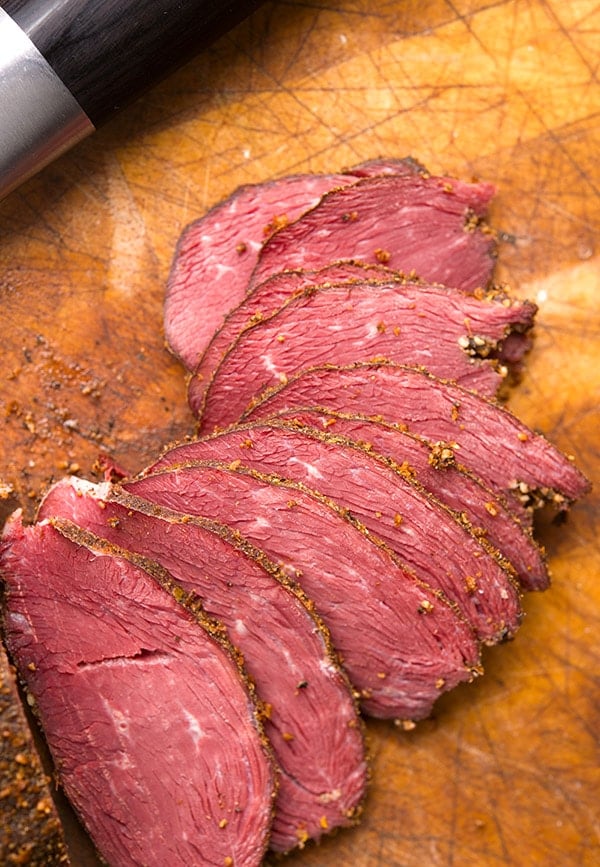
Goose pastrami is what I do with most of my Canada goose breasts. It is an easy project that makes the most out of these often-tough slabs of meat.
Why geese? Well, Canada and snow geese are very close to grass-fed beef in flavor (they eat the same thing), they have large, easy-to-work-with breasts, and they do have a tendency to be tough, which means that any way you can cook them that lets you slice the breasts thinly is a good thing.
Pastrami, in case you’ve never had it, is a cured meat from Eastern Europe or Turkey — remember the Ottomans ran Eastern Europe for a while — that’s normally beef or mutton. Although here’s an interesting tidbit from Wikipedia: “Among Jewish Romanians, goose breasts were commonly made into pastrami because they were inexpensive.”
So there ya go. This is traditional!
To make pastrami, you dry cure (sometimes brine) the meat for a few days, dry it a bit, coat it in the characteristic black pepper and coriander and then smoke it. Sliced thin on a sandwich, it’s God’s gift. Good pastrami at a Jewish deli is something you must eat at least once before you die.
If you have any goose breasts in your freezer, go for it. A pastrami on rye with good mustard, a slice of cheese and maybe some sauerkraut, and you got yourself some awesome there!
Once you make your pastrami, it will need to be eaten within a week or two, or you’ll need to vacuum seal and freeze it.\
Goose Pastrami
Ingredients
- 2 skinless Canada goose (or domestic goose breasts
- Kosher salt see recipe notes
- 3 grams Instacure No. 1, good for up to 3 pounds of goose
- 1/2 teaspoon dried thyme
- 1/4 teaspoon celery seed
- 1/4 teaspoon caraway seed
- 1 teaspoon sugar
- 1/4 teaspoon crushed juniper optional
- 1 teaspoon ground black pepper plus 1 tablespoon ground black pepper
- 1/4 cup brandy red wine, vinegar or water
- 1 tablespoon ground coriander
Instructions
- Weigh your goose breasts. For every pound of goose, you'll need 10 grams of kosher salt, which is about a tablespoon. It's OK if you are a little off on this measurement. Mix the salt, curing salt, sugar as well as the thyme, celery seed, caraway, juniper and the teaspoon of black pepper and grind them all together in a spice grinder. Pack the goose breasts with this mixture, massaging it into the meat. Put the goose into a closed container in the fridge for 24 to 72 hours.
- When you are ready, rinse off the goose and pat it dry. It's fine if you have a little bit of the cure stuck to the meat, but you don't want too much. Put the goose breasts on a rack in the fridge and let them dry uncovered for a day.
- Dip the goose into the brandy -- or really any other liquid you want -- and then coat thoroughly in the remaining black pepper and ground coriander seed. I like to grind this myself so the texture is a little coarse, a little fine.
- Smoke the goose breasts until the interior hits 140°F, which takes me about 3 hours.
- Let the goose pastrami cool and eat as lunch meat, or on crackers or whatever.
Notes
Nutrition
Nutrition information is automatically calculated, so should only be used as an approximation.
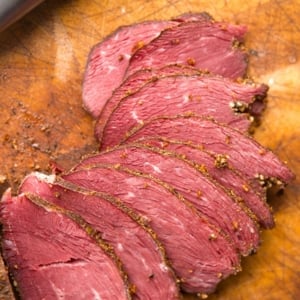
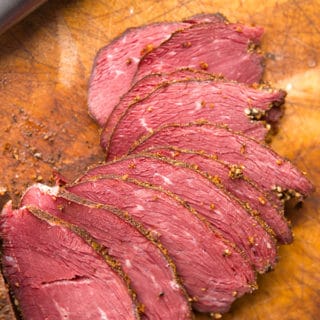

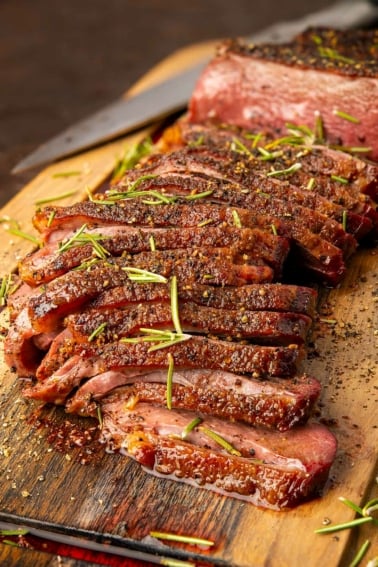
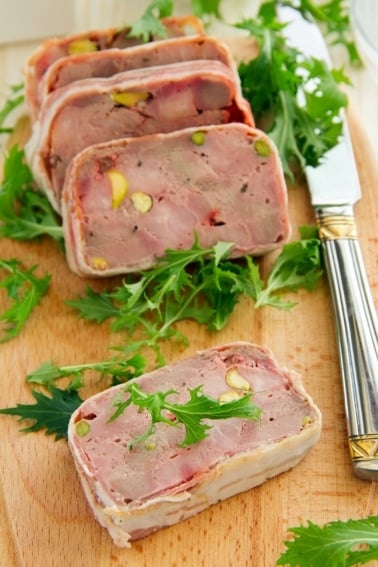

Hank: I have 6 lbs of this in the refrigerator curing and am looking ahead to the rub phase. I’d like the get the balance between the pepper and coriander correct. The recipe says to use 1 T ground coriander but in the comments you indicate you grind your own. Do I start with 1T whole seeds and go from there, or is it 1T after they have been ground. Also, would it be beneficial to use whole peppercorns and grind them as well? Looking forward to the finished product on Monday.
Mark: It’s all up to you. Those measurements are very loose. I do grind my own spices for this, though, so yes, it helps to have a spice grinder. Some people like more coriander, some more pepper. Your call. I go 50-50.
Do I have to let them dry for a day or can it just be for a few hours with maybe a fan on them?
Tom: A few hours with a fan works, too.
Just made this for the 2nd time. Favorite wild game recipe ever! This time was a 10lb batch and I must’ve had the salt measurement off. Much more salty flavor. Anyone have any recommendations on how to remedy this? Best I can come up with is to slice ultra thin like prosciutto and eat with something sweet like cantaloupe.
One thing that made a significant difference was slicing the breast the long way, instead of across. The muscle fibers run several different ways but this direction gave me the most cross fiber cut. The result was a much more tender texture. Great stuff.
I’ve made two batches of this with Canada geese we harvested in Virginia this year. I have finally found a way to prepare these birds that actually tastes GREAT! Need to pull them from a smoker just a bit sooner (this batch went to 155 deg as I was not paying proper attention) but the flavor is just terrific. (Smoke was Pitmaster’s Choice pellets from Amazen products – smoked for 4 hours at 190 deg in a MES30) Thank you for sharing this great recipe!
I just finished my first batch. Pastrami sandwiches are on tomorrows lunch menu!
Next time I will adjust a couple of things. I’ll marinate for 24 hours instead of 30, I won’t make the final rub as heavy(fortunately, it’s easy to remove the excess when it’s done), and I’ll probably use different wood. I used oak and pecan this time. Next batch I’m thinking hickory and cherry, or apple to give it a slightly sweeter smoke.
This is a great way to use goose.
I was leaning towards apple originally. I smoke all my turkeys with cherry and it NEVER disappoints. I live in NORCAL, so access to all kinds of orchards is pretty easy; I was thinking of visiting a few different ones to get a variety of fresh cut woods (pecan, peach, orange, apple) that I could air dry and have ready whenever I needed.
Hank, ONly qustion I have is what wood do you recommend for the smoke? I dont want something really heavy (mesquite) to overpower the flavor. SHould I stick to hardwoods (maybe white oak), or go with a milder wood (alder)
Jon: Oak is nice. I normally use fruit woods.
Hey Hank.
I think my last comment didn’t go through. bad internet?
I went through the recipe and the meat looks great, plus it was super simple! I was however really salty. I think maybe I need to get more exact with the instacure? I also had that fluid buildup that David got, and was curious if this could be to blamed?
Any other things to be sure of to make sure it doesn’t end up super salty again?
Thanks
-Kedrik
I wish I could include a picture here because my first attempt at Canada goose pastrami (or goostrami as a friend called it) was picture perfect!! Wasn’t sure what my target temp for the smoker was. Ultimately took just under 5hrs @160F to acheive an internal temp of 145F. Let it cool a bit and sliced into it. The outer layer of meat was a little tough to get through but the inside was surprisingly tender and moist still. And to my surprise, completely pink admittedly I was concerned I’d have a grey layer in there because I doubted the process (never used a dry brine/cure before). I will most definitely be making this again (and again and again). Thanks for the recipe!!
Andrea
I cure my own Canadian bacon too from boneless loins using Mortons tender quick and usually prick them all over with a skewer. One tablespoon /pound of meat, and the same amount of brown sugar.This allows the cure to get to the middle. You could try that with the goose breasts too, the holes from the skewers don’t show.
Mike: I and every other serious maker of cured meats hates Morton’s tenderquick. It’s a crappy product that removes any control you have over the process. It is a proprietary blend of salt, nitrite and sugar that makes it tough to work with unless you use the company’s own recipes. That is the reason they do this, BTW. I highly recommend that anyone remotely interested in good charcuterie buy real curing salt and use their own ratios of salt and sugar. Oh, and skewering the meat does nothing. The cure is salt based and it enters the meat via osmosis, not mechanically. Piercing the meat just damages it. Bottom line: Try my version. It will actually taste like real pastrami.
I made about 15 pounds of this a few weeks ago and I couldn’t believe how good the meat turned out. I think my measurements were off slightly as it was a little too peppery but it was still great. I’ve given a bit away and gotten tons of compliments on it so far.
We served mini pastrami sandwiches as one of the dishes at a waterfowl dinner and it was a hit. Also made some smoked goose sausage, goose jerky, and sauteed duck breasts; most recipes came from here or your books. Thanks for everything!
My Canadian breasts are all rubbed and closed up in the fridge. Should I pour the liquid that collects out every so often or keep it in?
Thanks
David: Pour it off.
Tried these with a big gander’s breast this week. Just finished up last night and my wife said that they might have been the best thing I have ever cooked (I wasn’t sure whether to be happy or hurt :D). I don’t have the bag and seal gear so skipped to the bottom on the cooking… I also went with some Calvados, as I don’t have any Brandy around. I have a Traeger, and they went four hours at 180 degrees, and still weren’t hitting the 165 safe mark. I pulled them off the smoker, put them in an open foil “boat” and drizzled them with another table spoon of Calvados. I “floated” them in a pan with about a 1/2 inch of water and then sealed the whole thing with foil. Oven at 325 for 90 minutes, and they hit 167 degree, board cooled them, and Wow. Served with Dijon, gherkins, and hard grain crackers. Very happy – and I really appreciate the recipe. Thanks for your labors!
Paul
Thank you for posting this recipe! It is, indeed, fantastic. Cold up here in Canada and I tried to sneak another smoking session in but I couldn’t get it up to temperature. After 3 hours of smoking, I pulled it out and used my oven to finish it (I admit, I don’t know if this was a good call). Thermometers were all askew as well. The perfect storm. Never-the-less, the Pastrami turned out and is quite tasty, although I’d hazard to guess it would be better when I can finish it in the smoker.
In reards to the Tenderquick, I have seen folks on other forums using this, but I’m not sure if it’s a 1:1 ratio. The Nitricure product that I use was a success.
Tyler: That’s actually a great idea, finishing it in the oven. I’ve done that many times to good effect.
I don’t have any instacure on hand – could I substitute Morton Tenderquick?
If not, where should I look for this instacure?
Honestly I’ve never used tenderquick. Can anyone out there help Chad?
Hank, I gave this recipe a try this weekend with four crane breasts. Wow. So good.
Hank,
Finishing up these goose breasts. My Masterbult electric, with 10 breasts in it, running at 200, got the breasts up to 145 in an hour! I turned the temp down. Suggestions to keep the smoke going for 3 hrs?
Smoking times and temps are all voodoo, when it all boils down to it. In your case, drop the temperate of the smoker. The Instacure you put in the goose breasts will keep away any bad bugs you can sometimes get when cooking at lower temps.
Hank,
Rick Cope (another member of the YHC) and I both made goose pastrami last weekend using your recipe. WOW! The pastrami turned out amazing! Rick used it to make reuben’s and reported that his entire family loved them! I’ve been eating pastrami sandwiches all week. The ladies that I work with at the bank tried the pastrami and asked for more. This may be one of the easiest and successful uses of skinned canada goose breasts. I can envision mounds of pastrami that will result from the 3 to 5 man limits we will shoot this upcoming season!
Thanks again,
Todd Baier
Hank, those look great! I’ve made pastrami but used brine instead of dry rub. My problem is that the cure never seems to reach the center of the meat. The middle is gray while the rest is that lovely cured pink. I’ll try your method next time.